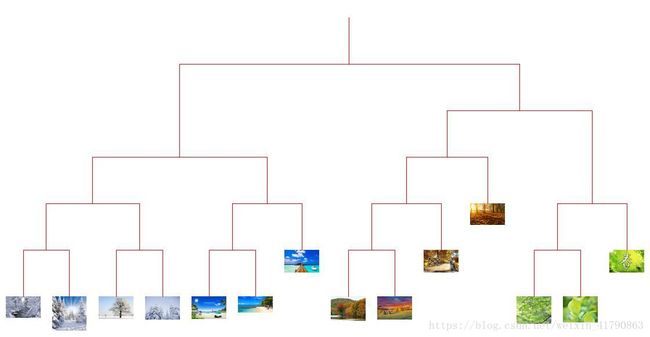8.4 层次聚类(Hierarchical Clustering)应用
层次聚类算法实现:
from numpy import *
"""
Code for hierarchical clustering, modified from
Programming Collective Intelligence by Toby Segaran
(O'Reilly Media 2007, page 33).
"""
class cluster_node:
def __init__(self,vec,left=None,right=None,distance=0.0,id=None,count=1):
self.left=left
self.right=right
self.vec=vec
self.id=id
self.distance=distance
self.count=count #only used for weighted average
def L2dist(v1,v2):
return sqrt(sum((v1-v2)**2))
def L1dist(v1,v2):
return sum(abs(v1-v2))
# def Chi2dist(v1,v2):
# return sqrt(sum((v1-v2)**2))
def hcluster(features,distance=L2dist):
#cluster the rows of the "features" matrix
distances={}
currentclustid=-1
# clusters are initially just the individual rows
clust=[cluster_node(array(features[i]),id=i) for i in range(len(features))]
while len(clust)>1:
lowestpair=(0,1)
closest=distance(clust[0].vec,clust[1].vec)
# loop through every pair looking for the smallest distance
for i in range(len(clust)):
for j in range(i+1,len(clust)):
# distances is the cache of distance calculations
if (clust[i].id,clust[j].id) not in distances:
distances[(clust[i].id,clust[j].id)]=distance(clust[i].vec,clust[j].vec)
d=distances[(clust[i].id,clust[j].id)]
if d=0:
# positive id means that this is a leaf
return [clust.id]
else:
# check the right and left branches
cl = []
cr = []
if clust.left!=None:
cl = get_cluster_elements(clust.left)
if clust.right!=None:
cr = get_cluster_elements(clust.right)
return cl+cr
def printclust(clust,labels=None,n=0):
# indent to make a hierarchy layout
for i in range(n): print (' '),
if clust.id<0:
# negative id means that this is branch
print ('-')
else:
# positive id means that this is an endpoint
if labels==None: print (clust.id)
else: print (labels[clust.id])
# now print the right and left branches
if clust.left!=None: printclust(clust.left,labels=labels,n=n+1)
if clust.right!=None: printclust(clust.right,labels=labels,n=n+1)
def getheight(clust):
# Is this an endpoint? Then the height is just 1
if clust.left==None and clust.right==None: return 1
# Otherwise the height is the same of the heights of
# each branch
return getheight(clust.left)+getheight(clust.right)
def getdepth(clust):
# The distance of an endpoint is 0.0
if clust.left==None and clust.right==None: return 0
# The distance of a branch is the greater of its two sides
# plus its own distance
return max(getdepth(clust.left),getdepth(clust.right))+clust.distance
层次聚类算法应用:
此处麦子学院没有提供层次聚类算法应用代码,代码是我从网上找的:
# -*- coding:utf-8 -*-
from PIL import ImageDraw, Image
import numpy as np
import os
import sys
nodeList = [] # 用于存储所有的节点,包含图片节点,与聚类后的节点
distance = {} # 用于存储所有每两个节点的距离,数据格式{(node1.id,node2.id):30.0,(node2.id,node3.id):40.0}
class node:
def __init__(self, data):
'''每个样本及样本合并后节点的类
data:接受两种格式,
1、当为字符(string)时,是图片的地址,同时也表示这个节点就是图片
2、合并后的类,传入的格式为(leftNode,rightNode) 即当前类表示合并后的新类,而对应的左右节点就是子节点
'''
self.id = len(nodeList) # 设置一个ID,以nodeList当然长度为ID,在本例中ID本身没太大用处,只是如果看代码时,有时要看指向时有点用
self.parent = None # 指向合并后的类
self.pos = None # 用于最后绘制节构图使用,赋值时为(x,y,w,h)格式
if type(data) == type(""):
'''节点为图片'''
self.imgData = Image.open(data)
self.left = None
self.right = None
self.level = 0 # 图片为最终的子节点,所有图片的层级都为0,设置层级是为了最终绘制结构图
npTmp = np.array(self.imgData).reshape(-1, 3) # 将图片数据转化为numpy数据,shape为(高,宽,3),3为颜色通道
npTmp = npTmp.reshape(-1, 3) # 重新排列,shape为(高*宽,3)
self.feature = npTmp.mean(axis=0) # 计算RGB三个颜色通道均值
else:
'''节点为合成的新类'''
self.imgData = None
self.left = data[0]
self.right = data[1]
self.left.parent = self
self.right.parent = self
self.level = max(self.left.level, self.right.level) + 1 # 层级为左右节高层级的级数+1
self.feature = (self.left.feature + self.right.feature) / 2 # 两类的合成一类时,就是左右节点的feature相加/2
# 计算该类与每个其他类的距离,并存入distance
for x in nodeList:
distance[(x, self)] = np.sqrt(np.sum((x.feature - self.feature) ** 2))
nodeList.append(self) # 将本类加入nodeList变量
def drawNode(self, img, draw, vLineLenght):
# 绘制结构图
if self.pos == None: return
if self.left == None:
# 如果是图片
self.imgData.thumbnail((self.pos[2], self.pos[3]))
img.paste(self.imgData, (self.pos[0], self.pos[1]))
draw.line((int(self.pos[0] + self.pos[2] / 2)
, self.pos[1] - vLineLenght
, int(self.pos[0] + self.pos[2] / 2)
, self.pos[1])
, fill=(255, 0, 0))
else:
# 如果不是图片
draw.line((int(self.pos[0])
, self.pos[1]
, int(self.pos[0] + self.pos[2])
, self.pos[1])
, fill=(255, 0, 0))
draw.line((int(self.pos[0] + self.pos[2] / 2)
, self.pos[1]
, int(self.pos[0] + self.pos[2] / 2)
, self.pos[1] - self.pos[3])
, fill=(255, 0, 0))
def loadImg(path):
'''path 图片目录,根据自己存的地方改写'''
files = None
try:
files = os.listdir(path)
except:
print('未正确读取目录:' + path + ',图片目录,请根据自己存的地方改写,并保证没有hierarchicalResult.jpg,该文件为最后生成文件')
return None
for i in files:
if os.path.splitext(i)[1].lower() == '.jpg' and os.path.splitext(i)[0].lower() != 'hierarchicalresult':
fileName = os.path.join(path, i)
node(fileName)
return os.path.join(path, 'hierarchicalResult.jpg')
def getMinDistance():
'''从distance中过滤出未分类的结点,并读取最小的距离'''
vars = list(filter(lambda x: x[0].parent == None and x[1].parent == None, distance))
minDist = vars[0]
for x in vars:
if minDist == None or distance[x] < distance[minDist]:
minDist = x
return minDist
def createTree():
while len(list(filter(lambda x: x.parent == None, nodeList))) > 1: # 合并到最后时,只有一个类,只要有两个以上未合并,就循环
minDist = getMinDistance()
# 创建非图片的节点,之所以把[1]做为左节点,因为绘图时的需要,
# 在不断的产生非图片节点时,在nodeList的后面的一般是新节点,但绘图时绘在左边
node((minDist[1], minDist[0]))
return nodeList[-1] # 最后一个插入的节点就是要节点
def run():
root = createTree() # 创建树结构
# 一句话的PYTON,实现二叉树的左右根遍历,通过通过遍历,进行排序后,取出图片,做为最底层的打印
sortTree = lambda node: ([] if node.left == None else sortTree(node.left)) + (
[] if node.right == None else sortTree(node.right)) + [node]
treeTmp = sortTree(root)
treeTmp = list(filter(lambda x: x.left == None, treeTmp)) # 没有左节点的,即为图片
thumbSize = 60 # 缩略图的大小,,在60X60的小格内缩放
thumbSpace = 20 # 缩略图间距
vLineLenght = 80 # 上下节点,即每个level之间的高度
imgWidth = len(treeTmp) * (thumbSize + thumbSpace)
imgHeight = (root.level + 1) * vLineLenght + thumbSize + thumbSpace * 2
img = Image.new('RGB', (imgWidth, imgHeight), (255, 255, 255))
draw = ImageDraw.Draw(img)
for item in enumerate(treeTmp):
# 为所有图片增加绘图数据
x = item[0] * (thumbSize + thumbSpace) + thumbSpace / 2
y = imgHeight - thumbSize - thumbSpace / 2 - ((item[1].parent.level - 1) * vLineLenght)
w = item[1].imgData.width
h = item[1].imgData.height
if w > h:
h = h / w * thumbSize
w = thumbSize
else:
w = w / h * thumbSize
h = thumbSize
x += (thumbSize - w) / 2
item[1].pos = (int(x), int(y), int(w), int(h))
item[1].drawNode(img, draw, vLineLenght)
for x in range(1, root.level + 1):
# 为所有非图片增加绘图的数据
items = list(filter(lambda i: i.level == x, nodeList))
for item in items:
x = item.left.pos[0] + (item.left.pos[2] / 2)
w = item.right.pos[0] + (item.right.pos[2] / 2) - x
y = item.left.pos[1] - (item.level - item.left.level) * vLineLenght
h = ((item.parent.level if item.parent != None else item.level + 1) - item.level) * vLineLenght
item.pos = (int(x), int(y), int(w), int(h))
item.drawNode(img, draw, vLineLenght)
img.save(resultFile)
resultFile = loadImg(r"E:\PycharmProjects\python\HierarchicalClustering\dataset") # 读取数据,并返回最后结果要存储的文件名,目录根据自己存的位置进行修改
if resultFile != 'None':
run()
print("结构图生成成功,最终结构图存储于:" + resultFile)
结果:
D:\anaconda3\anaconda3install\python.exe E:/PycharmProjects/python/HierarchicalClustering/TestHierarchicalClustering.py
结构图生成成功,最终结构图存储于:E:\PycharmProjects\python\HierarchicalClustering\dataset\hierarchicalResult.jpg
进程已结束,退出代码0
